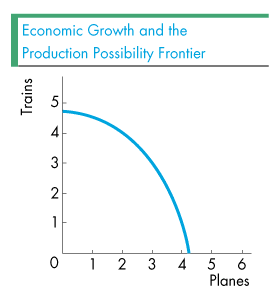Chapter 2 Summary of the Production Possibilities Frontier
It is important to note that all the points summarized above are illustrated using a two-good production possibility frontier but all are equally true in the real world with its billions of goods.
The production possibilities frontier is the first economic model we have met. We'll run across many more models in the future chapters. However, because the production possibilities frontier is the first model, you probably want to be sure you completely understand it. Fortunately, the Economics in Action software that is available to help you understand the material and the Study Guide that has been written to accompany the textbook both offer lots of help. In Economics in Action work all the multiple choice questions. In the Study Guide, answer True or False questions 5, 6, 7, 8, 9, 10, 11, 12, 15, and 16; Multiple Choice questions 10, 11, 12, and 13; and Short Answer questions 2, 5, and 7. If you have studied this web page, you definitely should not miss True or False questions 7, 10, 15, and 16; Multiple Choice questions 10 and 11; and Short Answer questions 5. If you miss any of these, re-study the material. For a solid grasp of the material, you probably should miss no more than 2 or 3 of the other questions. Would you like to study another chapter? |

